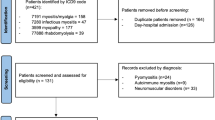Abstract
The clinical features of inclusion body myositis (IBM) were of minor importance in the design of consensus diagnostic criteria, mainly because of controversial views on the specificity of signs and symptoms, although some authors reported "typical" signs. To re–assess the clinical spectrum of IBM, a single investigator using a standard protocol studied a cohort of 64 patients cross–sectionally. Symptom onset was before the age of 50 years in 20% of cases. Only a few patients (14 %) started with weakness other than that of quadriceps, finger flexor or pharyngeal muscles. The sequence of power loss was erratic, but onset of symptoms with quadriceps weakness predicted an earlier onset of dysphagia in older patients (≥ 56 years) compared with younger ones (< 56 years) (p = 0.02). Despite widespread weakness patients had favourable scores on three commonly used function scales and they kept their employment. Complete wheel–chair dependency was rare (3 %). A dominant characteristic was the anatomical distribution of afflicted muscles: ventral extremity muscle groups were more affected than dorsal muscle groups and girdle muscles were least affected, the latter preserving postural stability. Ankylosis, especially in extension of the fingers,was frequently present. Together with the sparing of intrinsic hand muscles it was helpful in the preservation of many skilful movements.
IBM has a unique distribution of muscle weakness. Ankylotic contractures are common. We feel that their joint impact on daily functioning is characteristic for the disease.
Similar content being viewed by others
References
Aids to the examination of the peripheral nervous system (1990) 1st ed. Baillière Tindall, London
Amato AA, Gronseth GS, Jackson CE, Wolfe GI, Katz JS, Bryan WW, Barohn RJ (1996) Inclusion body myositis: clinical and pathological boundaries. Ann Neurol 40:581–586
Amato AA, Barohn RJ (1997) Idiopathic inflammatory myopathies. Neurol Clin 15:615–648
Badrising UA, Maat–Schieman M, van Duinen SG, Breedveld F, van Doorn P, van Engelen B, van den Hoogen F, Hoogendijk J, Howeler C, de Jager A, Jennekens F, Koehler P, van der Leeuw H, De Visser M, Verschuuren JJ, Wintzen AR (2000) Epidemiology of inclusion body myositis in the Netherlands: a nationwide study. Neurology 55:1385–1387
Badrising UA, Maat–Schieman ML, Ferrari MD, Zwinderman AH, Wessels JA, Breedveld FC, van Doorn PA, van Engelen BG, Hoogendijk JE, Howeler CJ, de Jager AE, Jennekens FG, Koehler PJ, De Visser M, Viddeleer A, Verschuuren JJ, Wintzen AR (2002) Comparison of weakness progression in inclusion body myositis during treatment with methotrexate or placebo. Ann Neurol 51:369–372
Barthel DW, Mahoney FI (1965) Functional evaluation; the Barthel index. Maryland State Med J 14:61–65
Beyenburg S, Zierz S, Jerusalem F (1993) Inclusion body myositis: clinical and histopathological features of 36 patients. Clin Investig 71:351–361
Brooke MH (1986) A clinician’s view of neuromuscular disorders. 2nd ed. Williams and Wilkins, Baltimore
Carpenter S, Karpati G, Heller I, Eisen A (1978) Inclusion body myositis: a distinct variety of idiopathic inflammatory myopathy. Neurology 28:8–17
Collen FM, Wade DT, Robb GF, Bradshaw CM (1991) The Rivermead Mobility Index: a further development of the Rivermead Motor Assessment. Int Disabil Stud 13:50–54
Dalakas MC, Koffman B, Fujii M, Spector S, Sivakumar K, Cupler E (2001) A controlled study of intravenous immunoglobulin combined with prednisone in the treatment of IBM. Neurology 56:323–327
Felice KJ, North WA (2001) Inclusion body myositis in Connecticut: observations in 35 patients during an 8–year period. Medicine 80:320–327
Felice KJ, Relva GM, Conway SR (1998) Further observations on forearm flexor weakness in inclusion body myositis. Muscle Nerve 21:659–661
Griggs RC, Askanas V, DiMauro S, Engel A, Karpati G, Mendell JR, Rowland LP (1995) Inclusion body myositis and myopathies. Ann Neurol 38:705–713
Lindberg C, Persson LI, Bjorkander J, Oldfors A (1994) Inclusion body myositis: clinical, morphological, physiological and laboratory findings in 18 cases. Acta Neurol Scand 89:123–131
Lotz BP, Engel AG, Nishino H, Stevens JC, Litchy WJ (1989) Inclusion body myositis. Observations in 40 patients. Brain 112:727–747
Peng A, Koffman BM, Malley JD, Dalakas MC (2000) Disease progression in sporadic inclusion body myositis: observations in 78 patients. Neurology 55:296–298
Phillips BA, Cala LA, Thickbroom GW, Melsom A, Zilko PJ, Mastaglia FL (2001) Patterns of muscle involvement in inclusion body myositis: clinical and magnetic resonance imaging study. Muscle Nerve 24:1526–1534
van der Ploeg RJO (1992) Hand–held dynamometry (thesis). Rijksuniversiteit Groningen, Groningen, pp 67–83
Ringel SP, Kenny CE, Neville HE, Giorno R, Carry MR (1987) Spectrum of inclusion body myositis. Arch Neurol 44:1154–1157
Rose MR, McDermott MP, Thornton CA, Palenski C, Martens WB, Griggs RC (2001) A prospective natural history study of inclusion body myositis: implications for clinical trials. Neurology 57:548–550
Sayers ME, Chou SM, Calabrese LH (1992) Inclusion body myositis: analysis of 32 cases. J Rheumatol 19:1385–1389
Verschuuren JJ, Badrising UA, Wintzen AR, van Engelen BGM, van der Hoeven H, Hoogendijk J (1997) Inclusion Body Myositis. In: Emery AEH (ed) Diagnostic Criteria for Neuromuscular Disorders. Royal Society of Medicine Press, London, pp 81–84
Walter MC, Lochmuller H, Toepfer M, Schlotter B, Reilich P, Schroder M, Muller–Felber W, Pongratz D (2000) High–dose immunoglobulin therapy in sporadic inclusion body myositis: a double–blind, placebo–controlled study. J Neurol 247:22–28
Wintzen AR, Badrising UA, Roos RA, Vielvoye J, Liauw L, Pauwels EK (1994) Dysphagia in ambulant patients with Parkinson’s disease: common, not dangerous. Can J Neurol Sci 21:53–56
Author information
Authors and Affiliations
Corresponding author
Rights and permissions
About this article
Cite this article
Badrising, U.A., Maat-Schieman, M.L.C., van Houwelingen, J.C. et al. Inclusion body myositis. J Neurol 252, 1448–1454 (2005). https://doi.org/10.1007/s00415-005-0884-y
Received:
Revised:
Accepted:
Published:
Issue Date:
DOI: https://doi.org/10.1007/s00415-005-0884-y




